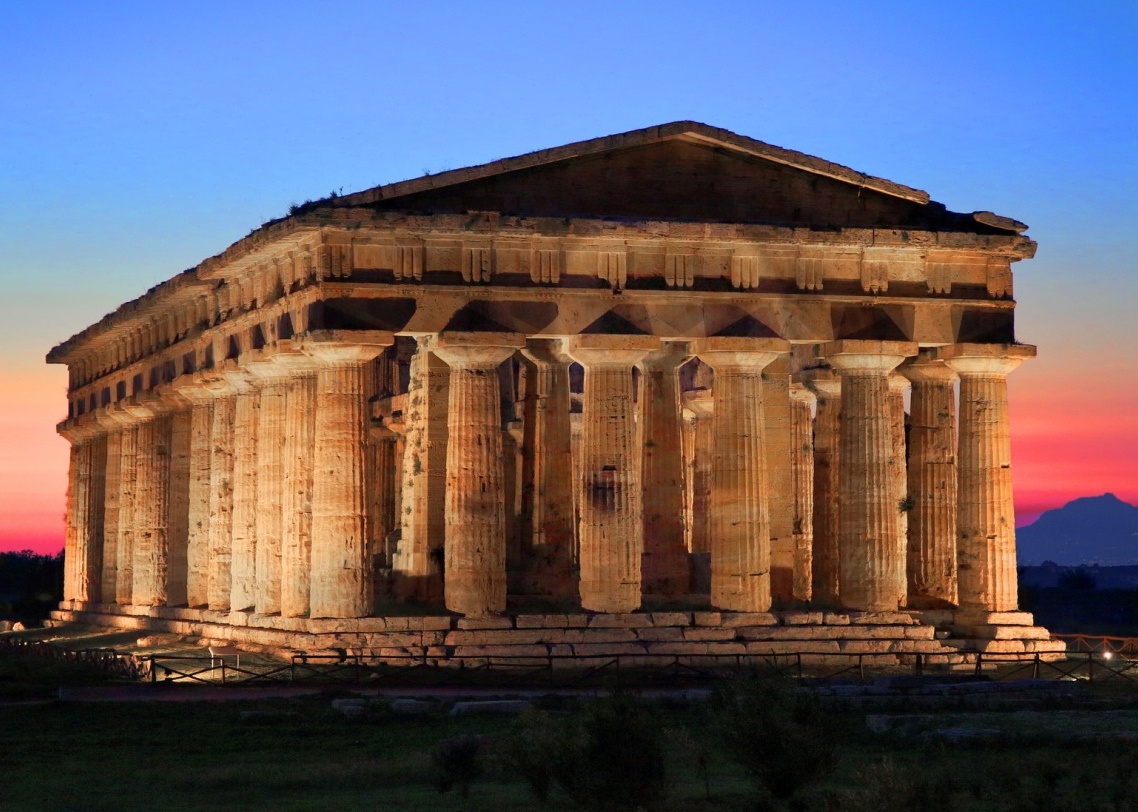
Cilento, terrain in the Region of Campania marked by gently-rolling hills covered in olive trees that see their reflection in the blue of the Tyrhennian, is pure magic and a crossroads between multiple populations and traditions. Traversed by savage torrents and thick woods of chestnuts and evergreens, this splendid landscape is also interspersed with villages clinging to its high, rough rocks, or towns that seem to cruise leisurely along its coasts.
It is here that the magnificent Cilento and Vallo di Diano National Park stands out with its archaeological sites of Paestum and Velia, and the Certosa of Padula; together, they have made up a UNESCO World Heritage List since 1998.
Cilento and Vallo di Diano National Park
The majestic Cilento and Vallo di Diano National Park (the second-largest in Italy) extends from the Tyrhennian coast to the feet of the Campania-Lucania Apennines, and preserves numerous traces of the presence of man since ancient times. The Park comprises the peaks of the Alburni, Cervati and Gelbison Mounts, in addition to the coastal buttresses of Monte Bulgheria and Monte Stella.
The Park’s floral population is constituted by approximately 1,800 different plant species, while the fauna is just as diverse, given, of course, the variety of environments spanning the territory.
Coastal and mountain areas, rivers and creeks also have a say in the contents of the animal community, graced by the frequent presence of highly-valuable species – for example, the peregrine falcon. On mountaintops and bluffs, and in the fields at high altitude, it is not uncommon to spot wolves, golden eagles (Aquila chrysaetos) and their prey of choice, the rock partridge (Alectoris graeca) and the Corsican hare (Lepus corsicanus).
Pairing with Cilento’s naturalistic characteristics and remarkable heterogeneity are the legendary and mysterious ambience, and a rich cultural history: it is here that the story of the nymph Leucosia is set, it is on the area’s beaches where Aeneas sees Palinurus for the final time in Virgil’s The Aeneid, it is where lie the remains of the ancient Greek colonies of Elea and Paestum, and it is here that we find the stupendous Certosa of Padula.
Of the many places of art contained within the Park, the foremost cultural attractives especially worthy of mention are Paestum, Velia and the Certosa of Padula. Important nationally and internationally, these sites are what garnered the prestigious UNESCO stamp for the Park.
Paestum
One of the most important monumental complexes left by Magna Graecia, its founders originally called it Poseidonia (in honor of Poseidon), but it is also a place for devotion to Hera and Athena. Paestum is a trove of innumerable archaeological finds and decorative artifacts – many of which can be viewed inside the National Archaeological Museum. Of immense beauty are the three Doric temples, still in excellent condition - so much so that they are considered unique exemplars of the architecture of Magna Graecia. The Temple of Neptune (530 B.C.), in actuality dedicated to Hera, is in sandstone and is the largest of Paestum’s temles. The Temple to Athena (500 B.C.) is additionally known for being dedicated to Ceres, while the Basilica (540 B.C.) is dedicated to Hera.
Elea/Velia
Velia, from the Greek name Elea, was founded in the 6th Century B.C.
What remains of the ancient city includes the port area, Porta Marina, Porta Rosa, the Hellenistic and Roman Thermal Baths, the Agora, the Acropolis, the South Quarter and the Archaic Quarter. Of indisputable value is Porta Rosa, prestigious monument with the double function of connecting the City’s two neighborhoods to the viaduct running to the top of the Acropolis.
The elements that make Velia UNESCO-worthy are its Eleatics School (Eleatics being a philosophy the proponents of which were Parmenides and Zeno, actually born in Velia).
The Certosa di San Lorenzo of Padula
The Certosa of Padula (in the Province of Salerno) – besides being the most famous of the Certosas - is the biggest in Italy. Founded as far back as 1306, this monastery boasts the largest cloister in the world (circa 129,167 ft²) and is circumscribed by 84 columns. Its main section, in the Baroque, occupies a surface area of 554,341 ft² and consists of more than 320 rooms. Today the Certosa hosts the Provincial Archaeological Museum of Western Lucania, exhibiting items found in the excavation sites of the Sala Consilina and Padula necropolises.



